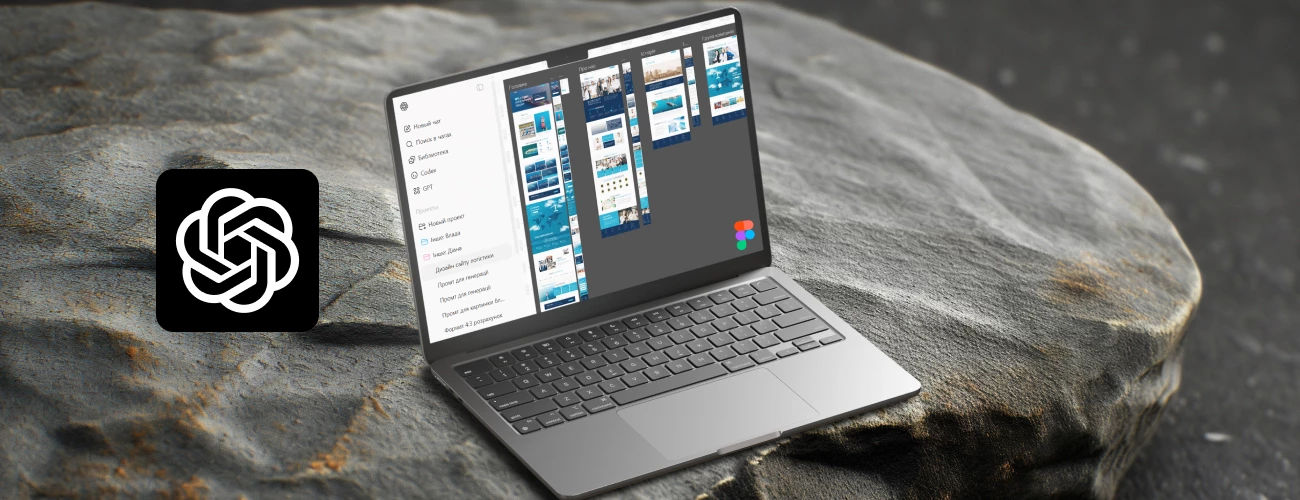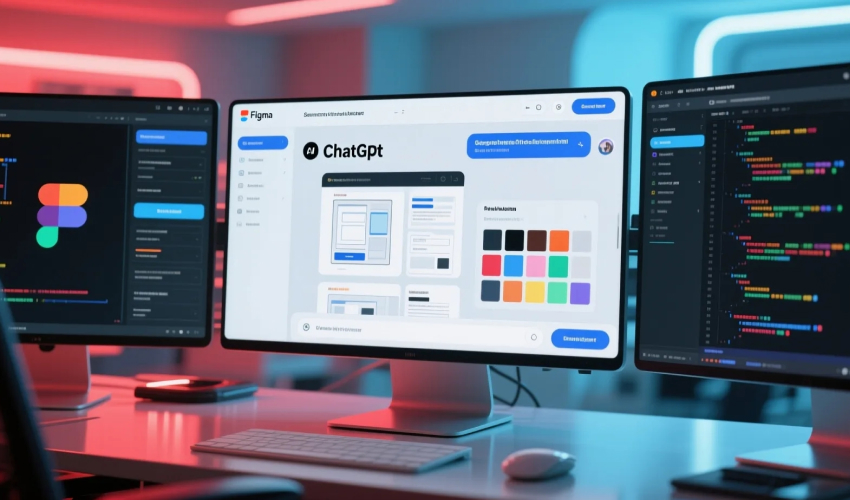The AI Revolution in Web Development: How the Apps SDK is Transforming ChatGPT into a New Website Building Platform

Just recently, launching a web project required working with different tools: a designer opened Figma, a developer — VS Code, and a manager — Trello. Today, you can start working on a website directly in a chat. OpenAI has introduced Apps SDK — a toolkit that allows ChatGPT to interact with external services (Figma, Canva, and FigJam) right inside the chat window.
From Figma to ChatGPT — a new entry point for web projects
Simply put, Apps SDK is like an “App Store,” but for ChatGPT. You connect the necessary services and use them directly in the chat, without switching between dozens of tabs. The integration of Figma and ChatGPT allows you to work with layouts and visual elements right in the dialogue.
For example, you can write: “Create a landing page for an IT company in dark colors with Hero, About, and Services sections” — and ChatGPT will call the connected apps, generate a layout, and display it directly in the chat window.
Full-scale development still requires standard tools. But the first prototypes can now be created faster and more conveniently thanks to artificial intelligence in design and the automation of website creation.
What changes with the introduction of Apps SDK:
- one entry point — the brief, design, and basic project logic appear right in the dialogue, without switching between services;
- faster edits — AI in web development allows you to quickly create and modify a prototype without waiting for files to move from designer to developer;
- all services in one place — Figma, Canva, GitHub, and other tools now work directly inside ChatGPT, as built-in elements;
- simplified teamwork — layouts, content, and code are created in the chat and can be instantly shared with Figma, Canva, or other tools;
- new testing opportunities — thanks to developer mode, you can launch and test your own apps directly in the chat.
Currently, Apps SDK is available in preview mode, and publishing apps or using some advanced features is still limited. However, the trend is clear: ChatGPT for website creation is becoming a new starting environment for web development — from idea to prototype. It doesn’t replace Figma or VS Code but makes the first step toward a project faster, more intuitive, and closer to how we naturally communicate.
What is Apps SDK and why it’s a breakthrough
OpenAI Apps SDK is a set of tools and specifications that let developers connect third-party applications directly to ChatGPT. This turns ChatGPT Apps SDK into not just a text-generation tool but a full-fledged platform for managing apps within the OpenAI ecosystem — where conversation becomes the interface.
Capabilities of Apps SDK include:
- invoking and integrating external applications;
- creating visuals — Canva and other tools can generate graphics directly on request;
- working with data — CRM, CMS, and analytics integrations allow AI to use context and update information in real time;
- rendering interactive elements — mini-apps can display UI components right in the chat while keeping logic on the server for security;
- managing workflows through dialogue — all actions are performed using natural language.
Why is this a breakthrough in product and UX terms? ChatGPT plugins simplify website development by transforming interaction with tools into a “conversational” format. The user describes a task in natural language, and the platform itself calls and combines the necessary services. The main interface element becomes the chat query — not a series of clicks through menus.

How it works in practice
Everything that previously required switching between dozens of services can now be done directly in the chat.
Examples of ChatGPT use for different specialists:
- a web designer types: “Figma, create a wireframe for a corporate website with three products and a CTA button in the Hero section.” Chat connects to Figma, and AI generates the layout right inside the chat;
- a content manager says: “Canva, make a banner for the ‘About Us’ page in the style of our website.” The system activates Canva, creates several banner variations with the brand colors, logo, and text, and displays previews in the chat;
- a business owner writes: “FigJam, build a customer journey map for a new product based on previous data.” The assistant generates a diagram that appears directly in the chat.
The user gives a command in plain language — no technical jargon. ChatGPT, through Apps SDK, activates the necessary service, executes the task, and returns the result to the chat. The result can then be reviewed, edited, or opened in the full service interface.
What it means for web studios and developers
Benefits of implementing AI for web studios:
- fewer routine steps — the brief, layout, and code merge into a single workflow;
- better coordination — designers, copywriters, and clients work “inside the dialogue,” seeing real-time changes;
- a new UX model — Conversational Development, where websites are built through natural language commands;
- effective AI integration in UX and UI — automation allows fast interface and visual creation, adapting styles, elements, and texts to project requirements.
Web studios that quickly adopt dialog-based app management and properly organize workflows will significantly increase development efficiency with AI. They’ll be able to create solutions faster and present them to clients more effectively.
Conclusion: from websites to dialogue systems
Apps SDK is not just a set of plugins — it’s a transformation of the website creation process into a conversational format. For designers and developers, ChatGPT becomes a workspace where text or voice replaces the mouse, and one dialogue replaces dozens of tabs.
The AI design of the future allows the creation of interfaces and visual solutions directly in the chat, and it’s already changing the web landscape. Soon, websites will no longer be static pages people “just visit,” but interactive companions. Those who first implement conversational interfaces will set the new market standard and gain a competitive edge.
To learn more about the future of web development with AI, contact MEGASITE web studio. For over 10 years, we’ve been creating turnkey websites in Kyiv and across Ukraine, helping businesses implement modern, intelligent solutions.
Your project
Call/write:


